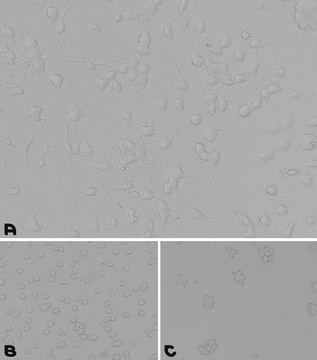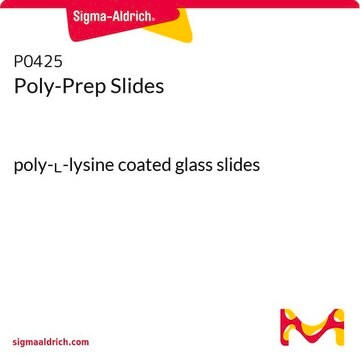추천 제품
product name
Poly-L-Lysine Solution, 0.01%
니들 크기
2.0 mm
Quality Level
무균
sterile
형태
liquid
분자량
Mw 84000 Da
제조업체/상표
NovaSeptum®
농도
0.01 % (w/v)
0.1 mg/mL
기술
cell attachment: suitable
cell culture | mammalian: suitable
배송 상태
dry ice
저장 온도
−20°C
일반 설명
Poly-L-Lysine is a synthetic amino acid chain that is positively charged having one hydrobromide per unit of Lysine. Poly-L-Lysine is widely used as a coating to enhance cell attachment and adhesion to both plasticware and glass surfaces. Certain cell types secrete proteases, which can digest Poly-L-Lysine.
The molecular weight of Poly-L-Lysine for cell culture can vary significantly, with lower molecular weight (30,000 Da) being less viscous and higher molecular weight (greater than 300,000 Da) having more binding sites per molecule. This product uses a Poly-L-Lysine of 84000 Da, yielding a solution viscosity for easy handling while providing sufficient binding sites for cell attachment.
The molecular weight of Poly-L-Lysine for cell culture can vary significantly, with lower molecular weight (30,000 Da) being less viscous and higher molecular weight (greater than 300,000 Da) having more binding sites per molecule. This product uses a Poly-L-Lysine of 84000 Da, yielding a solution viscosity for easy handling while providing sufficient binding sites for cell attachment.
애플리케이션
Poly-L-Lysine Solution has been used to coat culture dishes to culture U2-OS cells and primary cortical neurons.
생화학적/생리학적 작용
Poly-L-lysine serves as a coating substance to ensure better attachment of cells to culture surfaces. Research shows that plates coated with poly-L-lysine (PLL) demonstrated an accelerated cell growth rate. Culturing mesenchymal stem cells (MSCs) on PLL-coated substrates has been found to safeguard the stemness properties of these cells and inhibit senescence. PLL-coated plates have demonstrated enhanced MSC growth and up-regulated the expression of genes associated with cell adhesion, differentiation, proliferation, and signaling. Moreover, porous PLL-coated surfaces have shown improvements in cell proliferation and the osteogenic differentiation of MSCs.
품질
Solution is clear with no particulates present. Solution is sterile and suitable for cell culture applications.
제조 메모
Optimal coating concentrations must be determined by the end user. Typical coating concentrations range from 10ug/ml to 100ug/ml based on cell type and application.
1. Thaw Poly-L-Lysine solution at room temperature.
2. Dilute Poly-L-Lysine solution to the desired concentration in sterile water.
3. Fully coat the cell culture surface with diluted Poly-L-Lysine solution. Use 5 mL volume for 6-cm plates and 10 mL volume for 10-cm plates and T75 flasks.
4. Allow the cell culture vessel to sit at room temperature overnight.
5. Aspirate the Poly-L-Lysine solution the following day and rinse the vessel with sterile water followed by coating with desired ECM protein.
1. Thaw Poly-L-Lysine solution at room temperature.
2. Dilute Poly-L-Lysine solution to the desired concentration in sterile water.
3. Fully coat the cell culture surface with diluted Poly-L-Lysine solution. Use 5 mL volume for 6-cm plates and 10 mL volume for 10-cm plates and T75 flasks.
4. Allow the cell culture vessel to sit at room temperature overnight.
5. Aspirate the Poly-L-Lysine solution the following day and rinse the vessel with sterile water followed by coating with desired ECM protein.
법적 정보
NOVASEPTUM is a registered trademark of Merck KGaA, Darmstadt, Germany
Storage Class Code
12 - Non Combustible Liquids
WGK
WGK 1
Flash Point (°F)
Not applicable
Flash Point (°C)
Not applicable
시험 성적서(COA)
제품의 로트/배치 번호를 입력하여 시험 성적서(COA)을 검색하십시오. 로트 및 배치 번호는 제품 라벨에 있는 ‘로트’ 또는 ‘배치’라는 용어 뒤에서 찾을 수 있습니다.
이미 열람한 고객
Direct addition of poly-lysine or poly-ethylenimine to the medium: A simple alternative to plate pre-coating
Alexander Faussner, et al.
PLoS ONE, 17(7), e0260173-e0260173 (2022)
Srsf1 and Elavl1 act antagonistically on neuronal fate choice in the developing neocortex by controlling TrkC receptor isoform expression
A Ioana Weber, et al.
Nucleic Acids Research, 10218-10237 (2023)
Polylysine for skin regeneration: A review of recent advances and future perspectives
Zarrintaj P, et al.
Bioengineering & translational medicine, 5;7(1) (2022)
Poly-L-lysine Prevents Senescence and Augments Growth in Culturing Mesenchymal Stem Cells Ex Viv
Heo JS, et al.
BioMed Research International (2016)
Ana Popović et al.
Journal of cell science, 136(5) (2023-03-03)
Myosin-X (MYO10), a molecular motor localizing to filopodia, is thought to transport various cargo to filopodia tips, modulating filopodia function. However, only a few MYO10 cargoes have been described. Here, using GFP-Trap and BioID approaches combined with mass spectrometry, we
문서
Extracellular matrix proteins such as laminin, collagen, and fibronectin can be used as cell attachment substrates in cell culture.
자사의 과학자팀은 생명 과학, 재료 과학, 화학 합성, 크로마토그래피, 분석 및 기타 많은 영역을 포함한 모든 과학 분야에 경험이 있습니다..
고객지원팀으로 연락바랍니다.








